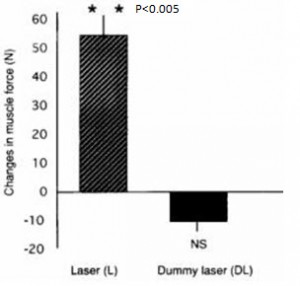Shoulder tendinopathy is caused by irritation or damage to the tendons of the muscles in the shoulder. This is often caused by repeated microtrauma such as impingement as a result of the acromion rubbing against the rotator cuff when the arm is raised. The raising of the arm narrows the space between acromion and the rotator cuff making the bursa less likely to protect the tendons. This will cause tendons to become inflamed and swollen causing pain to the patient and sometimes loss in strength and motion. Research has shown that low level laser can be an effective therapy for this condition.
Find out more about low-level lasers
Low-level laser and local corticosteroid injection in the treatment of subacromial impingement syndrome: a controlled clinical trial. Kelle B, Kozanoglu E. Clin Rehabilitation, Feb 11 2014.
- Controlled clinical trial.
- 135 subjects with subacromial impingement syndrome.
- Subjects were allocated to three groups according to their order of admission:
- Local corticosteroid injection (group I) – injections were administered twice, with an interval of 10 days between each.
- Sham laser treatment (group II) – the treatment procedure was the same as for group III, with the exception that the laser device was not turned on.
- Low-level laser treatment (group III) – GaAs 904nm; 2J/cm² – performed 3x per week for a total of 9 sessions.
- Subjects were assessed at pre-treatment, post-treatment and 3 and 6 months after the first visit. The primary outcome of the study was pain intensity (visual analog scale) during activity and at rest. The secondary outcomes were, shoulder functional status and quality of life measured by the University of California at Los Angeles rating score (UCLA) and Nottingham Health Profile (NHP) scale respectively.
- Significant differences were observed between groups I and II and between groups II and III regarding pain during activity and at rest scores at all of the visits (p<0.05). Group I and III had significantly greater pain VAS reductions than group II at all time points. Only for the post-treatment test, pain VAS score was significantly more improved in group I than group III. For all other time points there was no significant differnce between group I and III. The UCLA scores (shoulder function) were significantly changed in all three study groups at all of the visits. Improvements were significantly greater in group I and III versus group II.
- The effectiveness of low-level laser treatment was similar to that of local corticosteroid injection in patients with subacromial impingement syndrome. Both low-level laser treatment and corticosteroid injection were more effective than sham laser treatment.
Low-level laser therapy versus ultrasound therapy in the treatment of subacromial impingement syndrome: a randomised clinical trial. Yavuz F, Duman I, Taskaynatan MA, Tan AK. J Back Musculoskelet Rehabilitation, Dec 17 2013.
- Prospective, observer-blinded, randomized clinical trial.
- 31 subjects with subacromial impingement syndrome were randomly assigned to low-level laser therapy group (n=16) and ultrasound therapy group (n=15).
- Study participants received 10 treatment sessions of low-level laser therapy (3J/cm², total 15J) or ultrasound therapy (1MHz, 2W/cm²) over a period of two-consecutive weeks (5 days/wk).
- Outcome measures used included: visual analogue pain scale (0-100mm), Shoulder Pain and Disability Index (SPADI), patient’s satisfactory level (VAS 1-100mm), sleep interference score (0-10 points scale). Subjects were assessed before treatment and at the 1st and 3rd months after treatment. All patients were analyzed by the intent-to-treat principle.
- The results show that both LLLT and US therapy provide significant pain relief and functional improvement in patients with SAIS. In addition, there is no significant difference between outcomes (primary and secondary) of two physical therapy modalities.
- LLLT may be considered as an effective alternative to ultrasound based therapy in patients with subacromial impingement syndrome especially ultrasound based therapy is contraindicated.
The efficacy of low-level laser therapy in supraspinatus tendinitis. Saunders L. Clinical Rehabilitation, May 1995;9(2):126-134
- Double-blind randomised controlled trial.
- 24 patients with supraspinatus tendinitis randomly assigned to two groups whichreceived a course of 9 treatments and identical advice and educational material:
- the laser group was treated with a low- power laser using a 820 nm, 40 mW probe operating at 5000 Hz to produce a dose of 30 J/cm2.
- the control group was treated with a similar, but sham laser.
- Outcomes included perceived pain was assessed and tenderness and secondary muscle weakness measured before and after the course of treatment.
- The results showed that laser therapy, advice and education improved certain symptoms of supraspinatus tendinitis, while the same advice and education but treatment with a sham laser had no such beneficial consequences.
- Significant improvement of pain and secondary weakness with laser treatment compared to placebo in supraspinatus tendinitis.
The use of low-level laser therapy in the treatment of trigger points that are associated with rotator cuff tendonitis. Al-Shenqiti A, Oldham J.
- 60 patients with rotator cuff tendinitis (duration between 6 wks and 18 months). Participants were randomly allocated to one of two groups: sham or laser therapy.
- The laser parameters used were a wavelength of 820 nm, a power output of 100 mW, a frequency of 5000 Hz (modulated) and energy density of 32 J/cm2. The two groups received a course of 12 treatment sessions for four weeks (3 sessions per week).
- Outcomes (pain, functional activities measured using the Shoulder Pain and Disability Index (SPADI), pressure pain threshold (PPT), range of motion (ROM))were assessed pre and post treatment, with a 3-month follow-up assessment.
- The findings of the current study suggest that LLLT is effective in treating patients with TrPs associated with rotator cuff tendonitis, when using the parameters described. The difference with sham therapy was highly significant after treatment and at follow-up.
- Significant improvement of pain, ROM and function with LLLT trigger point treatment in patients with rotator cuff tendinitis.

